|
HOME: www.hiltonpond.org |
|||
THIS MONTH at (Back to Preceding Week; on to Next Week) |
|
•TROPICAL HUMMINGBIRD EXPEDITIONS• We're now enrolling for Costa Rica East & Guatemala (both Nov 2013). (Click on logo above for itineraries & trip details.)
|
All maps, charts, text & photos © Hilton Pond Center THE "CHAYODOCE" IN COSTA RICA: PREFACE A couple of years ago Ernesto Carman Jr., one of the top nature guides in all of Central America, was exploring Ujarrás in the Orosi Valley of Costa Rica (see map above)--just southeast of San Jose in Cartago Province and near his home at Finca Cristina in Paraíso. 'Nesto (below right) has been deeply involved with Operation RubyThroat's Central American expeditions since they began 'way back in 2004.
All text, maps & photos © Hilton Pond Center To learn more about the recently discovered winter concentration of migratory ruby-throats at Ujarrás, in November 2011 Hilton Pond Center mounted its first Neotropical expedition to the "east" side of Costa Rica--actually, the Central Valley--and met with unprecedented success. (See Hummingbirds In Costa Rica: The Chayoteers At Ujarrás.) During last year's nine-day trip, our citizen science volunteers from across the U.S. deployed mist nets among Chayote arbors and helped capture RTHU for banding; we also caught and banded ruby-throats using traps at a rustic restaurant conveniently situated in the middle of our study site. After such good results--45 new RTHU banded--we recruited another dozen citizen scientists for this year's trip and in November 2012 returned to the Chayote fields to see what else we might learn. Our most recent successes are summarized in text and photos below. • PRE-ARRIVAL ACTIVITIES • The 2012 Costa Rica East expedition began, as usual, with Operation RubyThroat's principal investigator and trip leader Bill Hilton Jr. departing York SC and Hilton Pond Center a few days ahead of the group on 8 November. Incidentally, Chayote (AKA "mirliton," "cho-cho," "christophene," and/or "pear squash") is a food staple in many Latino cultures and can be used in everything from soup to cake; the entire plant is edible from root to stem to leaf. Most of Costa Rica's Chayote fruit (a green variety is shown above left) is exported to Europe, so what you see in the produce section of your local grocery store in the U.S. likely came from the Mexican state of Veracruz. • DAY ONE • Early on the morning of 10 November the Omega Team was off for the airport in San Jose, where over a few hours we met flights and greeted 12 folks who had signed on for our autumn 2012 expedition to Costa Rica.
All text, maps & photos © Hilton Pond Center As a rewarding sign of customer satisfaction, fully half the group consisted of people who had been on at least one of our previous Operation RubyThroat Neotropical trips. Passing through customs were these old friends: Anne Beckwith (Durham NC), spouses Mary Kimberly & Gavin MacDonald (Decatur GA), Kathy Roggenkamp (Carrboro NC), and spouses Gail & Tom Walder (Wilson NY). Anne & Kathy were alumni from Costa Rica West 2008 & Guatemala 2011; Mary & Gavin did Costa Rica West 2009 & Guatemala 2011; and the Walders were the real "old-timers" of the bunch, having been on Costa Rica West back in 2008. Interestingly, all six of these veteran citizen scientists also had been together for Belize 2010, so for them and the trip leaders our latest expedition was almost like a family reunion! The more-than-welcome "newbies" on the team were Peggy Keller & spouses Cindy & Phil Marino (all three from Rochester NY), sisters Carol & Joan Schneier (of Marietta GA & Fayetteville NC, respectively), and Ann Truesdale (Meggett SC). In the photo above, l to r, Joan, Ann, and Carol exit immigration with smiles on their faces, happy to see a familiar Operation RubyThroat T-shirt waiting for them in Costa Rica.
All text, maps & photos © Hilton Pond Center When participants exited the arrival area 'Nesto and Guillermo "Whiskers" Hernandez (above, Pura vida!)--a conscientious driver and obvious Bob Marley lover we've used on several of our trips--hustled luggage onto our sleek-and-shiny air conditioned tour bus before everyone took lunch at the airport restaurant. Having had their first taste of Costa Rican fare, the team boarded the bus for a two-hour ride east through San Jose, Cartago, and Paraíso, arriving late afternoon in Orosi at Tapanti Media Lodge Bar & Restaurant, where everyone settled into their comfortable rooms. After a sumptuous supper on the outdoor balcony at Tapanti's restaurant, folks gathered for the usual evening meeting--during which we summarized the history of Operation RubyThroat's first 17 Neotropical expeditions and described plans for the next day's activities. As is our tradition, we announced we'd be selecting a memorable nickname for the group after we got to see everyone in action. We also challenged the new group to catch as many Ruby-throated Hummingbirds as did the pioneering "Chayoteers" in during our first banding expedition to Ujarrás in 2011. The number of RTHU bandings last year was 44--although due to a transcription error we mistakenly told the new group it was 45. • DAY TWO •
All text, maps & photos © Hilton Pond Center The first day of field work always goes a bit slow because it involves teaching group members how to unpack mist nets, designate new net lanes, place 42-foot long nets on 10-foot-tall poles, and deploy each net beneath Chayote arbors without fouling delicate mesh on trellis wires and abundant vegetation. (NOTE: Because Chayote arbors are only about six feet tall, we aren't able to open fully our eight-foot-tall mist nets; the bottom shelf remains closed. See photo above, with Tom Walder conscientiously waiting for captures.) However, with six veterans among the 12 team members things went faster than usual--especially since the "newbies" were quite industrious and quick to catch on. It was likewise quite helpful that four of our newcomers were banders or had mist netting experience; Cindy & Phil Marino and Peggy Keller all had done banding work at Braddock Bay Bird Observatory in Upstate New York, and Carol Schneier had volunteered at Jekyll Island (GA) Banding Station and Fish Springs National Wildlife Refuge in Utah. After demonstrating their expertise, Cindy, Peggy, and Carol all provided valuable assistance with bird extraction--a task that sometimes works net-tenders 'Nesto and Ela nearly to the point of exhaustion as they run around those five-acre Chayote plots. Most of our 14 nets were in place at about 9:30 a.m. and by 10:05 a.m. we had in-hand our first Ruby-throated Hummingbirds of November 2012: TWO immature males with incomplete red gorgets. Both were in the same net and shelf at the same time, undoubtedly due to some sort of territorial chase. (Yes, we HAVE demonstrated that RTHU are about as territorial on their wintering grounds as they are around feeders and breeding locales back in North America.) That morning we caught two more immature male ruby-throats, one at 11:10 and the other at 11:50 a.m.
All text, maps & photos © Hilton Pond Center Our federal master bird banding permit allows us to apply U.S. bands to any bird we encounter in Costa Rica--so long as it's a Neotropical migrant that could be encountered back in North America; we may NOT apply bands to non-migratory resident species that we also catch frequently in our non-selective mist nets. Thus, on Day One we could capture and band three Tennessee Warblers and one brown-colored female Indigo Bunting (above), both of which breed in the U.S. or Canada. Those birds plus our four RTHU provided a nice start for 2012 before we closed nets just before noon and headed off to El Cas for lunch.
All text, maps & photos © Hilton Pond Center NOTE: We should point out that the four RTHU we caught on 11 November were NOT the first to be banded at Ujarrás in 2012. Just prior to our January Operation RubyThroat trip to Guanacaste Province in western Costa Rica, the Omega Group (Bill and Ernesto) had journeyed down to the Chayote plantation and set up portable Dawkins traps at El Cas. There, on 28-29 January 2012 we trapped and banded three male RTHU--all second-year birds that hatched in 2011 and still had incomplete red gorgets. As we shall see, one of these January "bonus" birds turned out to be pretty important.
All text, maps & photos © Hilton Pond Center During Day One lunch at El Cas with our 2012 team we hung our three Dawkins traps in the same locations we had used both for the 2011 expedition and during that two-day session in January 2012. Unfortunately, on this particular day we caught no ruby-throats during an hour of trap time, although we did extract a couple of those omnipresent but unbandable Rufous-tailed Hummingbirds (above).
All text, maps & photos © Hilton Pond Center After lunch we left the traps hanging but took out the feeders and closed the trapdoors--all in the hope Ruby-throated Hummingbirds would get more accustomed to the contraption and be less wary about entering. Then it was off for a short bus ride to Cartago and Lankester Botanical Garden, where Ernesto escorted us around the grounds and view the expansive indoor collection of native Costa Rican orchids. The facility houses several thousand orchid species--the vast majority of which have no common names and that look NOTHING like what one would wear as a corsage to a dance. (Trip participant Ann Truesdale was practically in heaven during this field trip; she raises orchids at her South Carolina Lowcountry home and was delighted to see so many of her favorite plants.) A lot of of these fascinating epiphytes were in bloom but it often was hard to tell without a magnifying glass; quite a few orchid species have flowers less than a quarter of an inch long! By comparison to these little blooms, Masdevalia laucheana (above), was almost a giant--even though its white, red, and yellow flowers measured only 1.5" from tip to tip. Found in primary (virgin) forests at altitudes from 3,000 to 4,500 feet, this orchid had flowers that smelled faintly of vanilla--an aroma that undoubtedly attracts miniscule flies, bees, or wasps as pollinators.
All text, maps & photos © Hilton Pond Center Even tinier than the Masdevalia was Lepanthes fimbriata (above)--an orchid with leaf-hugging orange flowers scarcely one-eighth of an inch long! This species is found along the central volcanic range from northern Costa Rica into western Panama.
All text, maps & photos © Hilton Pond Center One of our favorite orchids was the inch-long flower of Dresslerella pilosissima (above), named for Robert Dressler, current director at Lankester. We were honored to meet and dine with Dr. Dressler on previous trips to Costa Rica--encounters that always generated discussions of genealogy because wife Susan Hilton's middle name is Dressler, her mother having been one. (Alas, Robert and Susan appear to be unrelated.) • DAY THREE • All text, maps & photos © Hilton Pond Center On Day Two the team got an earlier start because net lanes were laid out and mist nets already were affixed to poles. Speed and efficiency allowed us to capture our first Ruby-throated Hummingbird--an immature male--at 8 a.m., followed by eight more through 11:25 a.m. That day we also banded seven Tennessee Warblers, one male Cape May Warbler, five Indigo Buntings,
All text, maps & photos © Hilton Pond Center The Cape May Warbler was an adult male in non-breeding plumage. When it was netted Ernesto immediately remarked that CMWA are quite uncommon in Costa Rica, so much so that when we returned home from the expedition we e-mailed Danny Bystrak at the federal Bird Banding Laboratory in Laurel MD--respository of all U.S. banding records. After a quick search of the BBL's computer database, Danny informed us ours was the first Cape May Warbler ever banded in Costa Rica by a U.S. bander, and that no migratory CMWA banded in North America had ever been encountered in this Central American country. Another first for Operation RubyThroat!
All text, maps & photos © Hilton Pond Center At 10:25 a.m. the team mist netted another bird of importance, but it wasn't "just another" Ruby-throated Hummingbird. No, this new hummer was special for two reasons: 1) She was the first female RTHU captured in 2012; and, 2) She was the 1,000th RTHU banded in the Neotropics through Operation RubyThroat. This is especially significant because prior to our work--which began in December 2004--only 46 ruby-throats had been banded in all of Mexico and the seven Central American countries where the species overwinters. (Incidentally, this female hummer brought the day's total for her species to 11, giving us 15 ruby-throats for November. As shown in the photo above, all RTHU banded in Costa Rica are color marked with temporary blue dye on the upper breast or throat. This allows us to monitor individual birds after banding and release.)
All text, maps & photos © Hilton Pond Center In celebration of Operation RubyThroat's 1,000th banded Ruby-throated Hummingbird in the Neotropics, the team posed with joy and satisfaction (above) as trip leader Hilton held that auspicious bird just prior to release.
All text, maps & photos © Hilton Pond Center That first-ever Cape May Warbler banded in Costa Rica and our 1,000th ruby-throat banded in the Neotropics weren't the only in-hand birds of interest on 12 November. That day we also caught an immature male Magenta-throated Woodstar (above) that was just starting to get his metallic gorget feathers.This non-migratory species occurs down the central volcanic ridge of Costa Rica and is endemic, occurring only in there and in western Panama. Of note in the photo above is the way this individual is replacing its white juvenal throat feathers with iridescent ones, some of which are still "in quill." After such an eventful morning we had lunch and then boarded the bus for an afternoon field trip to a destination at much higher altitude: Irazú Volcano National Park, elevation more than two miles. The park is above the frost line and parts are even above the timber line, so the pinnacle can be quite chilly and is devoid of trees. Irazú--the tallest volcano in Costa Rica at 11,260 feet--is active, although its most recent eruption in 1994 lasted only a day and did little damage. The last "big one" lasted a long time--from March 1963 through 1965.
All text, maps & photos © Hilton Pond Center Irazú's main caldera contains water whose level varies with rainfall. A second one--called Diego de la Hay--is mostly dry, with a footprint-shaped pool surrounded by a wide bed of dark ash. As we gazed down into this giant hole we saw a distant pair of wild Coyotes, Canis latrans (above), loping across the flats--stopping occasionally to sniff the surroundings and even lying down for a momentary break.
All text, maps & photos © Hilton Pond Center Unintentionally imitating the Coyotes, Anne Beckwith and Kathy Roggenkamp (above) explored another wide deposit of ash on top of Irazú. They were amazed to see just how much vegetation was growing in what appeared to be a very inhospitable habitat.
All text, maps & photos © Hilton Pond Center Irazú has its own special complement of high-altitude birds, including the Volcano Hummingbird and the long-legged yellow-eyed Volcano Junco (above). Both are endemic to high mountains of Costa Rica and western Panama.
All text, maps & photos © Hilton Pond Center Costa Rica's volcanoes also host a variety of interesting flora. Poor Man's Umbrella has individual leaves that can be four feet or more across but that start out small with heavily spiked petioles, veins, and margins (above). This armor undoubtedly protects new growth from destructive herbivores.
All text, maps & photos © Hilton Pond Center One plant that was in full flower during our November visit to Irazú was Senecio oerstedianus (above), known locally as Papelillo--which is also a Costa Rican term for cigarette papers. This member of the Sunflower Family (Compositae) is so distinctive it was selected--along with Volcano Hummingbird--to adorn the reverse Costa Rica's new high-end 20,000 colones paper currency (below).
All text, maps & photos © Hilton Pond Center We returned from Irazú just in time for supper on the balcony at Tapanti Lodge. After such an eventful day we decided it was time the group had a name, so at the evening meeting we explained that because the crew was doing research in Chayote fields, because the year was 2012, because there were 12 participants, and because the Spanish word for 12 is doce, our latest citizen science team would become known now and forevermore as the "Chayodoce." (The trip leader made up this word, of course, but thinks it has a good sound to it.) • DAY FOUR • All text, maps & photos © Hilton Pond Center Day Three of field work brought in five new Ruby-throated Hummingbird males between 7:18 a.m. and 11:25 a.m. including the first adult male with full red gorget; one female later hit the nets. Also netted by the Chayodoce on 13 November: 23 Tennessee Warblers, one Mourning Warbler, one Northern Waterthrush, and one Indigo Bunting. At lunch we decided to set traps at El Cas and between 1 and 2:10 p.m. trapped five additional male ruby-throats, including two more adults that brought our 2012 RTHU total to 25.
All text, maps & photos © Hilton Pond Center Along with the trapping of those five ruby-throats at El Cas something far more interesting and important also occurred. At 1:35 p.m. 'Nesto extracted from Trap #1 an apparent adult male Ruby-throated Hummingbird with a complete gorget (above). As we examined the bird closely, however, we noticed it already had a band on its left leg--and NO color mark. When we pointed this out to the Chayodoce, every member of the group froze and gave us complete attention; they knew immediately the significance of this newly captured, already-banded bird. Since it had no color mark, it couldn't have been a bird we'd banded in the past three days, so it was either a RTHU banded previously in North America or one of our Neotropical birds from an earlier Operation RubyThroat expedition. As we called out the band numbers, scribe-of-the-day Anne Beckwith recorded "C52199" on the recapture page of our field notes and then consulted banding records from last year. Thumbing through those pages for the band number, we learned some exceptionally good news: C52199 had been banded this past 29 January as an immature male with incomplete gorget; he was one of those three birds Bill and Ernesto had caught during their short trapping stint prior to the February 2012 Guanacaste expedition. This was cause for great jubilation among the Chayodoce. For one, C52199 was their first recapture. More important, however, it was a RETURN, meaning it came back to its banding locale at a later date--undoubtedly AFTER having flown north to the breeding grounds in North America before appearing AGAIN on the wintering grounds. As such, this particular bird was the first conclusive evidence that RTHU show site fidelity among the Chayote fields. Thus, Ujarrás becomes the third Central American locale where we have documented winter site fidelity for RTHU--the others being Crooked Tree at Belize and two sites ten miles apart in Guanacaste Province, Costa Rica. This was pretty exciting news because we were the first--and still only--researchers to document site fidelity for Ruby-throated Hummingbirds within their non-breeding range in the Neotropics.
All text, maps & photos © Hilton Pond Center One other thing worth noting about C52199. When we looked him over closely and prepared to color mark him with blue dye, we noticed his gorget feathers were distinctly two-tone (close-up above). We can only speculate at this point but suspect the two colors come from two different generations of gorget feathers, the bronzy ones representing the first set of iridescent plumage he produced last spring before migrating north. We suspect his redder feathers were next-generation replacements that began coming in before he migrated back south, and that he will continue to replace the bronze ones with red ones before going back north again in early 2013. Red coloration in an adult male RTHU's gorget feathers isn't pigment-related but is structural in nature; i.e., tiny air bubbles and microscopic grooves in the feathers scatter light, absorbing most spectral colors but reflecting red to the observer's eye. We believe ultraviolet light and physical wear alters the grooves and bubbles over time and affects scattering, making at least the feather tips look more orange than red. It may even be that first-generation feathers in young males are less structurally sound and are more affected by wear and tear than those grown by older birds. The question deserves further study and could result in a way to age older male RTHU more definitively.
All text, maps & photos © Hilton Pond Center Because of our extended lunch break and successful hummer trapping at El Cas, we decided to remain at Ujarrás for the rest of the afternoon, birding roadsides among the Chayote fields and paying a visit to the old church ruins (above) for which the town is best known. • DAY FIVE • We traditionally set aside the middle of our nine-day expeditions as "Hump Day" and let the team sleep in and rest up a little before embarking on a longer but low-key excursion that can't be accomplished on days we do morning field work. In Guanacaste we go to the beach, in Belize we take a leisurely boat ride on a freshwater lagoon, and for November trips to Costa Rica East we visit Rancho Naturalista. And what was really fortunate this year is that it rained on Hump Day--weather that would have cancelled mist netting activities but had positive impact on our goals at Rancho. Rancho Naturalista is an internationally renowned birding destination, primarily because for years the U.S. expatriate owners have been hanging hummingbird feeders and putting out fruit that attracts all sorts of other exotic birds. Although it's a 2.5-hour road trip, the pleasant eastbound bus ride to Rancho rolls past coffee plantations, fields of sugar cane, and scenic mountain vistas before ending up at the main lodge. There, our participants climb stairs to the second-floor open-air balcony--only to come nose-to-bill with an incredible assortment of hummingbirds that are essentially unafraid of humans.
All text, maps & photos © Hilton Pond Center Perhaps the most common and most cooperative hummers this year were Violet-crowned Woodnymphs (adult male above), whose multi-colored plumage glistened and sparkled despite overcast skies. Each individual staked out a feeder and tried to defend it from a perch in one of the thorn bushes nearby, but that was a hopeless effort. There was just too much competition from too many birds and a full-blown defense would have worn out any hummer that tried.
All text, maps & photos © Hilton Pond Center White-necked Jacobins (adult male above) were also present in abundance, although they seemed to spend far more time flying than perching. This is a largish hummingbird--at five inches it's length nearly twice the size of a ruby-throat--and when one hovered at a feeder we could feel a breeze created by the bird's wings.
All text, maps & photos © Hilton Pond Center Rufous-tailed Hummingbirds (above) were abundant, of course--we suspect they are the world's second-most-common hummingbird species, right after ruby-throats. One rufous-tail in particular spent the better part of 20 minutes bathing in the mist (above)--even tipping a nearby leaf to drop water onto itself before flicking off droplets by flapping its wings and shaking its tail.
All text, maps & photos © Hilton Pond Center There were other hummer species at the feeders or lurking in the vegetation, but our "find of the day" was a Bronze-tailed Plumeleteer (above), a hummingbird variety we had never seen. Formerly known as Pink-legged Hummingbird, this was a chunky four-inch-long hummingbird with long wings and tail. Our bird was an adult male--females are completely white beneath--that lorded over a first-floor feeder hidden in the shrubbery.
All text, maps & photos © Hilton Pond Center For our group, hummingbirds were the stars at Rancho Naturalista, but folks got to marvel over everything from bright-orange Baltimore Orioles to pendulum-tailed Blue-crowned Motmots (above), and from jumbo-sized Montezuma Oropendolas to banana-eating Scarlet-rumped Caciques with their pale blue eyes (below).
All text, maps & photos © Hilton Pond Center Following a tasty lunch on the lower terrace the Chayodoce spent a few more minutes in the rain searching for and finding Snowcaps--Rancho Naturalista's signature hummingbird species--and then we headed back west. Along the way we stopped for a guided tour of CATIE--the Tropical Agricultural Research & Higher Education Center where botanists, agronomists, and other scientists and students work at finding crops that will enable small-scale farms to become self-sustaining and profitable.
All text, maps & photos © Hilton Pond Center Our guide at CATIE laid out a 20-foot-long table with all sorts of fruits and vegetables the Center was investigating, including several different kinds of pods from the Chocolate Tree, Theobroma cacao. The six-inch pods in the photo above were filled with slimy white beans (lower right) that when properly prepared make world-class chocolate products. The beans were also pretty good to just suck on and provided the rush normally associated with fine chocolate.
All text, maps & photos © Hilton Pond Center On the trip back from Rancho Naturalista and CATIE we did not return to Tapanti Lodge but to a new place: Sanchiri Lodge & Mirador ("lookout"). This facility, which had been unavailable for the first half of our expedition, was at the top of the mountain overlooking our study site and 20 minutes closer, which would give us that more time in the field come morning. Sanchiri had big beds, enormous showers in each room, and window walls that provided a breathtaking look at the valley beyond (see photo above). This lofty perch also allowed us to look DOWN at Turkey Vultures and Black Vultures soaring on the thermals rising from the town beneath us. • DAY SIX • On Day Six it was back to the Chayote plantation at Ujarrás. However, following our strategy from 2011 we left Plot #1 and moved up the road to Plot #4, a somewhat hillier study site that runs beside a stream. There we took a while to establish new net lanes but had a dozen of them in place early enough to capture our first immature male RTHU by 7:13 a.m. (The Chayodoce were getting VERY efficient!) He was followed shortly thereafter by two females and just before lunchtime we had captured nine immature males, one adult male, and three females--making this our best day yet with 13 captures that brought the running total for 2012 to 38. We also netted and banded six Indigo Buntings, five Tennessee Warblers, one Yellow-bellied Flycatcher, one Northern Waterthrush, and one Gray-cheeked Thrush. This fourth day in the field--again, the first one in Plot #4--turned out to be spectacular not because it was our most productive for Ruby-throated Hummingbirds but because of an incredible series of events that began quite early. Here's how the morning went:
All text, maps & photos © Hilton Pond Center At 7 a.m. sharp one of the nets just erected in the new plot snared a Tennessee Warbler that was already banded. The aluminum didn't look all shiny like that on new ones we had been applying, and when we checked the number it turned out to be 2090-30052. A review of our records showed we had placed this band on the TEWA when it was caught at the same locale on 17 November 2011--almost exactly one year previously! Here was another sign of site fidelity in a species that--like Ruby-throated Hummingbirds--is a nectar-eating Neotropical migrant making good use of Chayote flowers around Ujarrás.
All text, maps & photos © Hilton Pond Center At 7:13 a.m. a different net snared a Northern Waterthrush that also bore a non-shiny band. Its number (1561-13082) showed it had been banded in Plot #4 last year on 19 November--another returnee. And this pattern continued all morning. At 8:50 a.m. a second Tennessee Warbler with band #2090-30090 had been captured in Plot #4 on 19 November last year. Then at 9 a.m. it was another Northern Waterthrush wearing band #1561-13081, just one number lower in the series than the one processed a little earlier that day; it had been banded in Plot #4 on 18 November 2011. Finally at 9:40 a.m. we netted a THIRD banded Tennessee Warbler (2090-30078), originally captured last year on 18 November. In less than 2.5 hours we had recaptured FIVE Neotropical migrants birds of two species--each of which had been banded in a three-day span almost exactly a year ago. Amazingly, we caught them within the same five-acre patch of Chayote (Plot #4) after they returned on a round-trip migratory trip took them as far north as Alaska or Newfoundland! We don't know if this is some kind or record for most returns in a 2.5-hour block of time, but it still boggles the mind that it happened.
All text, maps & photos © Hilton Pond Center Plot #4 also yielded an assortment of non-migratory tropical species that we couldn't band but certainly wanted to remember with photographs. One was a startlingly bright male Yellow-faced Grassquit (above). Costa Rica is home to nearly three dozen more-or-less related grassquits, seedeaters, finches, and sparrows (Emberizidae), but having gotten up close and personal with this particular species we think it might be our favorite local emberizid.
All text, maps & photos © Hilton Pond Center Not to be outdone by a grassquit, two colorful resident hummingbird species likewise hit our nets in Plot #4. The first was a Violet-headed Hummingbird (male above), one of which we had netted last year among the Chayote. Note the prominent white eyespot on this species.
All text, maps & photos © Hilton Pond Center The second was an even more iridescent hummer we knew from the previous day at Rancho Naturalista but had never had in-hand: A male Violet-crowned Woodnymph (above). This species looked pretty impressive at feeders at on perches at Rancho on Hump Day, but through the macro lens the bird was nothing less than spectacular. His metallic violet, blue, and green plumage defied description and had to be seen from inches away to truly be appreciated.
All text, maps & photos © Hilton Pond Center One other hummer we netted that day in the Chayote had a rather different appearance; we identified it as a young male Steely-vented Hummingbird. When we examined the gunmetal-colored undertail coverts that give the species its name, we noticed his tail feathers had a blue subterminal band (above). The Chayodoce were intrigued by this unusual marking that did not appear in field guide illustrations for the species.
All text, maps & photos © Hilton Pond Center As they pondered the situation, we held the hummer's tail up against the sky to reveal something quite interesting: While the tail appeared to have a dark band under reflected light, when backlit the tail showed a defect known as "fault bars." These occur especially in nestlings and indicate a day or two when weather was particularly bad, when the young did not receive proper nourishment, and/or when some other traumatic event occurred that resulted in structural weakness as the feathers were growing. In newly hatched nestling all tail feathers come in simultaneously, so fault bars are all the same distance from the feather tips. Such imperfections also occur in adult birds, but since adults don't typically molt all tail feathers at one time a fault bar may appear on just one replacement feather or perhaps on opposite ones if symmetrical molt is underway. After this look at fault bars in a steely-vented's tail, after the day's 13 banded Ruby-throated Hummingbirds, after FIVE returns of Tennessee Warblers and Northern Waterthrushes, As one of Costa Rica's first organic, shade-grown coffee farms, for more than two decades Finca Cristina has been an outstanding example of how coffee can be grown, harvested, and produced without an environment-damaging flood of pesticides, herbicides, fungicides, and other toxic chemicals. Owners Linda and Ernie Carman have high standards for their farm and product, and coffee connoisseurs say one good outcome is Café Cristina is one of the finest brews they've ever tasted. Linda and friends put together a splendid lunch for the Chayodoce--a meal that not coincidentally included a few dishes containing Chayote as the main ingredient!--after which Ernesto provided a tour of the finca and explained how they use biological controls against insect pests and composting techniques that improve soil rather than depleting it. Ernie followed up with a visit to the coffee mill where he showed off his original inventions used to clean, dry, and sort coffee beans after they're picked. From there Linda took everyone to reveal how their fine coffee is roasted, bagged, and shipped. All in all, it was a delightful learning experience punctuated by plenty of time to look at new species of birds frequenting the coffee trees--or bathing in mud puddles along the entry road. While at Finca Cristina we linked up with old friend Mark Garland (below right), a jovial naturalist and birding guide from Cape May NJ we know well from joint participation in West Virginia's annual New River Birding & Nature Festival. • DAY SEVEN • By our fifth day of field work the Chayodoce were getting very efficient, so much so that we had our first Ruby-throated Hummingbird capture--an immature male--by 6:35 a.m. Things slowed down considerably after that with just three more males caught in the nets, but two of those were adults. Female ruby-throats were nowhere to be seen. All told we caught four RTHU on 16 November, bringing the 2012 total to 42. That morning we also netted and banded a potful of Tennessee Warblers--37, to be exact--plus five Indigo Buntings, two Chestnut-sided Warblers, one Mourning Warbler, and one Northern Waterthrush.
All text, maps & photos © Hilton Pond Center For lunch that day we departed our study site and drove around Lake Cachi, a massive hydroelectric impoundment that adjoins those Chayote fields where we work. A 260-foot-tall arch dam that spans a deep ravine and forms the lake was built in the 1970s. Our destination was La Casona del Cafetal (translated as "House of the Coffee Plantation"), an expansive open air restaurant on the banks of the lake.
All text, maps & photos © Hilton Pond Center After the stomach-stretching meal at Casona we wandered the restaurant grounds, ever in pursuit of new bird species. There were several aquatic birds on the lake, including Belted Kingfishers, Snowy Egrets, and a Green Heron (above) perched on a bromeliad-festooned branch overhanging the water.
All text, maps & photos © Hilton Pond Center At the base of a big tree along the lake bank we came across another interesting sight, two meerschaum-shaped tubes covered with tiny, stingless bees only about three-sixteenths of an inch long. We had seen something similar elsewhere in Costa Rica--we always point out a bee colony at Junquillal Beach on the Pacific Ocean during our Costa Rica expeditions to Guanacaste Province--but the entry tubes at La Casona were much heaver and apparently older. These waxy tubes--created, maintained, and guarded by worker bees--lead to a hollow within the tree, where an industrious queen spends her hours and days and maybe even years laying egg after egg after egg to replenish the colony. This whole phenomenon of stingless bees with an intricate, long-lasting social set-up that enables the colony to serve an important role in pollinating native plants is nothing short of fascinating; we thoroughly enjoyed contemplating such things while sitting and watching the comings and goings of a seemingly endless parade of miniature bees.
All text, maps & photos © Hilton Pond Center After our pleasant sojourn at La Casona we headed back to our lodging at Sanchiri, stopping along the way at the Ujarrás lookout. From there we could gaze across the valley and see the church ruins that adjoin the very Chayote fields where we'd been working. The field furthest left in the photo above was Plot #1 where the Chayodoce ran mist nets during their first three days. (Plot #4 is on the near slope hidden by trees.) The Reventazon River that flows into Lake Cachi is in the background. • DAY EIGHT • The group's sixth and last day in the field created the ultimate challenge: Needing to capture three new RTHU to surpass last year's total of 44. The Chayodoce gave it a good shot but despite five hours of mist-netting things were very slow and we caught just one female RTHU by noon, bring the 2012 total to 43. Close, but no cigar! Nonetheless, the Chayodoce's success at capturing returning Neotropical migrants continued on 17 November with the netting of two more Tennessee Warblers that carried tarnished bands. These TEWA (2090-30088 and 2090-30091) had been banded in Plot #4 on 19 November 2011 and brought our number of returns in 2012 to five Tennessee Warblers, two Northern Waterthrushes, and one Ruby-throated Hummingbird--a pretty significant accomplishment no matter how you look at it!
All text, maps & photos © Hilton Pond Center Back in the mist nets among the Chayote we also banded 32 Tennessee Warblers that final day, plus two Yellow-bellied Flycatchers, one Mourning Warbler, one Indigo Bunting, one Swainson's Thrush, and one Gray-cheeked Thrush (above).
All text, maps & photos © Hilton Pond Center As a bonus, during the morning several group members had opportunity for great looks at an adult male Black-crested Coquette (above) that perched repeatedly above the banding table. Although the bird was so backlit it was hard to get good photos, folks were still pleased to add yet another hummer to their list.
All text, maps & photos © Hilton Pond Center On our final field day we came across some other interesting creatures. One was a cryptically colored caterpillar--likely from a Sphinx Moth--that lined up on a broken vine (above), revealing six "real" legs that indicated it was an insect. Also visible were five pairs of prolegs--so-called "false" legs that are extension's of the larva's abdomen. These clasping appendages allow the caterpillar to crawl and hold tight to surfaces but disappear when the larva becomes a moth.
All text, maps & photos © Hilton Pond Center The other invertebrate incident involved a mass of several hundred caterpillars we had found at the bottom of a tree trunk several days previous. These unidentified larva (above)--covered with long feathery spines and bearing two anterior antennae-like white-tipped appendages--resembled centipedes more than caterpillars. Each night they would ungroup and head up the tree to feed on foliage high above before returning to base camp by daylight. This prickly pile probably presents an unpalatable predicament for potential predators, but we found the whole scenario to be eye-pleasing; against the pastel shades of tree bark the caterpillars created an artistic, nearly abstract composition that hardly looked like a photograph. All text, maps & photos © Hilton Pond Center When we finished pulling mist nets and flagging tape at the end of our final work day, everyone gathered one more time beside the banding table for our traditional group photo (above)--a very handsome bunch all decked out on Operation RubyThroat T-shirts with mysterious magical powers! Then it was off one last time to lunch at El Cas, where the group's only hope for surpassing last year's Ruby-throated Hummingbird total was to run traps again while we ate. This turned out to be a very wise decision that resulted in capture of two more hatch year males, surpassing by one the Chayoteer's total from 2011. Mission accomplished with 45 Ruby-throated Hummingbirds banded for the Chayodoce!
All text, maps & photos © Hilton Pond Center After this success we headed to Tapanti National Park west of Orosi. This was the trip leader's first visit to the famous park--last year we had our first-ever attack of Montezuma's Revenge on the day that excursion was scheduled and the group went on with Ernesto. This year everyone was in fine shape and eager to visit a montane cloud forest whose trees are draped with epiphytic orchids, mosses, ferns, vines, and bromeliads (above) that thrive in high humidity. The Tapanti region is perhaps the wettest locale in Costa Rica, with 280 inches of rain on average each year. (That's more than 23 feet! By comparison, Hilton Pond Center, which lies in a relatively moist area of the Southeast, annually averages about 51"--scarcely more than four feet.)
All text, maps & photos © Hilton Pond Center Obviously it rains a lot in Tapanti National Park--as a group member said: "Well, it IS a cloud forest!"--so it was hard to take photos of all the birds and flora we encountered. We did manage to pull out our camera and telephoto lens for a few shots of one of the Satyria species (above), an epiphytic member of the Ericaceae (Blueberry Family). Its downward-hanging waxy red flowers, when open, are pollinated by several species of hummingbirds--including a long-billed Green-fronted Lancebill we watched for several minutes. These flowers eventually form upright bulbous berries relished by many kinds of frugivorous birds. As twilight descend on the cloud forest the bus headed back toward supper at Sanchiri Lodge, but we still had one more group goal to meet. On our second night together, three-time Operation RubyThroat veteran Anne Beckwith sang a little ditty about Water Ouzels. For the uninitiated, ouzels are water-loving passerine birds also known as Dippers, and they have the interesting behavior of diving into swift-moving mountain streams in pursuit of insects and other prey. They can even walk along creek bottoms.
All text, maps & photos © Hilton Pond Center It seems Ann and Kathy Roggenkamp had tried to find American Dippers on a previous trip to the western U.S. and had been stymied in their search, prompting Anne to write her top-40-quality song about ouzels--accompanying her singing on ukulele as shy Kathy giggled through the chorus of "Ouzel, ouzel, ouzel." With that hypnotic melody still resonating in our heads seven days later, Anne and Kathy prevailed upon us to stop at every stream crossing as we descended Tapanti. • DAY NINE •
All text, maps & photos © Hilton Pond Center Day Nine of the 2012 expedition was departure day for the Chayodoce, so after a final breakfast together Whiskers loaded everyone's luggage into the bus and off we went toward the San Jose airport. Mary Kimberly had faithfully recorded every bird species at least two group members had seen during the week and was responsible for our traditional "reading of the list." It was an impressive tally that--thanks to that last-minute American Dipper--ended up with 144 species. This, we believe, is the highest total we've ever had for an Operation RubyThroat expedition to Costa Rica, and probably even surpasses totals from our Guatemala or Belize trips. In celebration (above), Anne Beckwith retrieved her ukulele from the back of the bus and honored us one more time with her original rendition of "The Water Ouzel Song." By now we all knew the words and everyone joined in for that unforgettable chorus of "Ouzel, ouzel, ouzel." At the airport we off-loaded bags and--following hugs and fond farewells--directed our friends toward airline ticket counters, with the Omega Team (Ernesto and Bill) turning right around and heading back toward Finca Cristina. As usual we deployed our three Dawkins traps at the restaurant and sat back to see what might happen. Not much, it turns out. The day was overcast, dark, and dreary and few hummingbirds appeared; those that did enter the traps were unbandable Rufous-tailed Hummingbirds or already color-marked RTHU, so Ernesto and Jairo Jiménez Chaves (above left)--a young Costa Rican birder who had joined us in the field on several days--decided to put up a couple of mist nets along the long driveway into El Cas.
All text, maps & photos © Hilton Pond Center The nets caught all sorts of seedeaters and other unbandable resident species, the most unusual being a Paltry Tyrannulet--also known as Mistletoe Tyrannulet. As its name implies, this tiny flycatcher (see our fingers above for scale) specializes on eating mistletoe berries it later passes. Since the seeds themselves are sticky and indigestible, this bird does a very good job of disseminating parasitic mistletoe species common to much of Costa Rica. 'Nesto kept extracting and releasing unbandable birds from those two mist nets as the slow afternoon continued--until tall mountains around Ujarrás began casting long shadows on our study site. Despite careful monitoring of the traps, not a single new RTHU entered--although we did recapture the same banded and color marked bird four times! Finally, at 4:45 p.m. as we were about to give up and shut down our operation in the waning light, one more unbanded immature male ruby-throat hit one of our nets--bringing the November 2012 total to 46 banded ruby-throats. Those birds, plus the 44 from November 2011 and three we trapped at El Cas in January 2012 gave us 93 RTHU banded among the Chayote fields at Ujarrás--not a bad two-year tally for a location where Ruby-throated Hummingbirds were not even thought to occur. With that final hummer banded and released we shut our nets, returned to Finca Cristina, and bedded down for the night, with 'Nesto and Ela taking trip leader Bill to the airport early next morning for his flight back to Charlotte--following what can accurately be described as a productive and highly successful 18th Operation RubyThroat expedition to the Neotropics! Can't wait until the next one!
All text, maps & photos © Hilton Pond Center •UJARRÁS 2012 EXPEDITION RECAP• Our November 2012 Operation RubyThroat expedition to Ujarrás (in Costa Rica's Orosi Valley near Paraíso and just east of San Jose and Cartago) was indeed an big success, as determined in part by results outlined below. All text, maps & photos © Hilton Pond Center
All text, maps & photos © Hilton Pond Center All contributions are tax-deductible
See acknowledgement of recent supporters below After significant accomplishments in just two years at Ujarrás, we're eager to return next year to study Ruby-throated Hummingbirds among the Chayote. Participants can enroll now for the 6-14 November 2013 Operation RubyThroat expedition that will follow the same itinerary as the one described above for 2012. To sign up for this life-changing opportunity, see details at Costa Rica (east). No experience necessary! IMPORTANT NOTE: There are also a few coveted slots still available for our midwinter 2013 citizen science trips to Costa Rica (west) and Belize. Deadlines for both excursions are fast-approaching, so please contact Holbrook Travel's Debbie Sturdivant today at 866-748-6146 to reserve your place. One or both trips would make a great Christmas present for yourself, a friend, or a family member--and a portion of your trip fee is tax-deductible! For complete reports on all of Operation RubyThroat's successful Neotropical Hummingbird Banding Expeditions, please visit
This Week at Hilton Pond at the following links:
All text, maps & photos © Hilton Pond Center Our Operation RubyThroat hummingbird research in Costa Rica requires TWO passports (above), one issued by the U.S. government for travel to that country, and the other a scientific authorization from Costa Rican environmental authorities. We also are required to have permission from the federal Bird Banding Laboratory in Laurel MD to apply U.S. bands to Ruby-throated Hummingbirds and other Neotropical migrants we capture in Central America. Color marking ruby-throats with temporary dye requires additional BBL authorization. Please scroll down for additional info. |
 The Piedmont Naturalist, Volume 1 (1986)--long out-of-print--has been re-published by author Bill Hilton Jr. as an e-Book downloadable to read on your iPad, iPhone, Nook, Kindle, or desktop computer. Click on the image at left for information about ordering. All proceeds benefit education, research, and conservation work of Hilton Pond Center for Piedmont Natural History. The Piedmont Naturalist, Volume 1 (1986)--long out-of-print--has been re-published by author Bill Hilton Jr. as an e-Book downloadable to read on your iPad, iPhone, Nook, Kindle, or desktop computer. Click on the image at left for information about ordering. All proceeds benefit education, research, and conservation work of Hilton Pond Center for Piedmont Natural History. |
|
|
"This Week at Hilton Pond" is written and photographed by Bill Hilton Jr., executive director of Hilton Pond Center for Piedmont Natural History
|
|
|
Please refer "This Week at Hilton Pond" to others by clicking on this button: |
Comments or questions about this week's installment? Send an E-mail to INFO. (Be sure to scroll down for a tally of birds banded/recaptured during the period, plus other nature notes.) |

Click on image at right for live Web cam of Hilton Pond,
plus daily weather summary
Transmission of weather data from Hilton Pond Center via WeatherSnoop for Mac.
|
--SEARCH OUR SITE-- For a free on-line subscription to "This Week at Hilton Pond," send us an |
|
Thanks to the following fine folks for recent gifts in support of Hilton Pond Center for Piedmont Natural History and/or Operation RubyThroat: The Hummingbird Project. Your tax-deductible contributions allow us to continue writing, photographing, and sharing "This Week at Hilton Pond" with students, teachers, and the general public. Please see Support or look below if you'd like to make a tax-deductible gift of your own.
• MIST NET SPONSORSHIPS •
|
If you enjoy "This Week at Hilton Pond," please help support Hilton Pond Center for Piedmont Natural History. It's painless, and YOU can make a difference! (Just CLICK on a logo below or send a check if you like; see Support for address.) |
|
Make credit card donations on-line via Network for Good: |
|
Use your PayPal account to make direct donations: |
|
If you like shopping on-line please become a member of iGive, through which 950+ on-line stores from Amazon to Lands' End and even iTunes donate a percentage of your purchase price to support Hilton Pond Center.  Every new member who registers with iGive and makes a purchase through them earns an ADDITIONAL $5 for the Center. You can even do Web searches through iGive and earn a penny per search--sometimes TWO--for the cause! Please enroll by going to the iGive Web site. It's a painless, important way for YOU to support our on-going work in conservation, education, and research. Add the iGive Toolbar to your browser and register Operation RubyThroat as your preferred charity to make it even easier to help Hilton Pond Center when you shop. Every new member who registers with iGive and makes a purchase through them earns an ADDITIONAL $5 for the Center. You can even do Web searches through iGive and earn a penny per search--sometimes TWO--for the cause! Please enroll by going to the iGive Web site. It's a painless, important way for YOU to support our on-going work in conservation, education, and research. Add the iGive Toolbar to your browser and register Operation RubyThroat as your preferred charity to make it even easier to help Hilton Pond Center when you shop. |
|
BIRDS BANDED THIS MONTH at HILTON POND CENTER 1-30 November 2012 |
|
|
SPECIES BANDED THIS MONTH: * = New species for 2012 MONTHLY BANDING TOTAL: 7 species 33 individuals 2012 BANDING TOTAL: 31-YEAR BANDING GRAND TOTAL: (since 28 June 1982, during which time 171 species have been observed on or over the property) 126 species (31-yr avg = 67.3) 58,104 individuals (31-yr avg = 1,874) NOTABLE RECAPTURES THIS MONTH: Northern Cardinal (1) White-throated Sparrow (2) Eastern Tufted Titmouse (1) Hermit Thrush (1) Red-bellied Woodpecker (1)
|
OTHER NATURE NOTES: --After our recent tongue-in-cheek photo essay about an "invasion" by ONE Red-breasted Nuthatch, on 4 Nov the irruption did actually occur with FOUR of them banded--bringing our Hilton Pond total since 1982 to 16! Never before had we banded more than three in one calendar year, and today there two in the same net at the same time. Of the new birds, two were dark-crowned males, with two pale-crowned females. A day later on 5 Nov we also got our first Pine Siskin, Dark-eyed Junco, and Purple Finch of the fall. --Chilly! The Center's overnight low of 24.3 degrees F. came at 6:43 a.m. on 25 Nov--coldest day of the season so far by five degrees. Current weather for the Center is updated every few minutes with a brand-new Web cam image via Weather Underground. --If you missed our most recent photo essay it was about Getting Ready for Winter--how plants we found at Hilton Pond Center have been preparing to make it through upcoming cold months. See Installment #555. All text & photos © Hilton Pond Center |


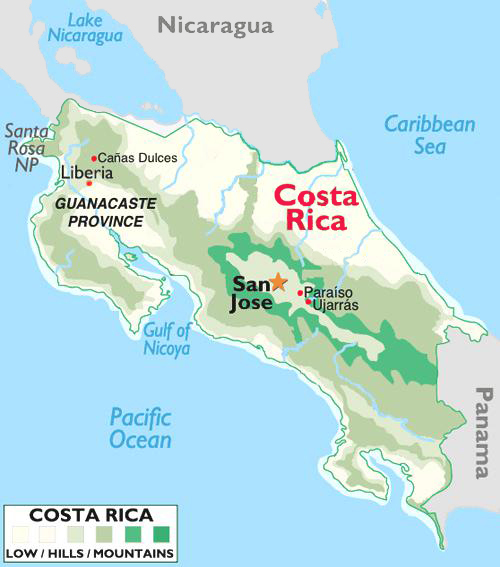
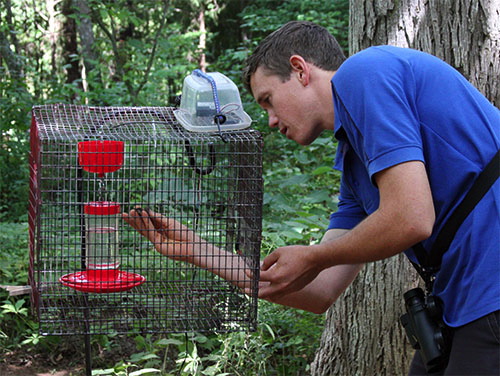 After all, it was HE who discovered a significant non-breeding population of Ruby-throated Hummingbirds within Aloe vera plantations near Liberia (Guanacaste Province) on Costa Rica's Pacific Coast; that population has revealed much new information about what RTHU do during the OTHER half of the year when they're not in the U.S. or Canada. Since that first trip 'Nesto has become a close friend and full collaborator in our efforts to learn about RTHU in the Neotropics; from September through early May he always has eyes and ears open for wintering ruby-throats in his home country. Such vigilance led to his second big discovery--that Ruby-throated Hummingbirds (and other hummer species) were taking advantage of yet another agricultural crop: Vast fields of Chayote squash (Sechium edule) cultivated in rich bottomland soils at Ujarrás (below). It wasn't a surprise that this "new" population of ruby-throats would be drawn to Chayote's copious nectar supply, but it WAS unexpected that a sizable concentration of RTHU was so far east in Costa Rica--where they "aren't supposed to be."
After all, it was HE who discovered a significant non-breeding population of Ruby-throated Hummingbirds within Aloe vera plantations near Liberia (Guanacaste Province) on Costa Rica's Pacific Coast; that population has revealed much new information about what RTHU do during the OTHER half of the year when they're not in the U.S. or Canada. Since that first trip 'Nesto has become a close friend and full collaborator in our efforts to learn about RTHU in the Neotropics; from September through early May he always has eyes and ears open for wintering ruby-throats in his home country. Such vigilance led to his second big discovery--that Ruby-throated Hummingbirds (and other hummer species) were taking advantage of yet another agricultural crop: Vast fields of Chayote squash (Sechium edule) cultivated in rich bottomland soils at Ujarrás (below). It wasn't a surprise that this "new" population of ruby-throats would be drawn to Chayote's copious nectar supply, but it WAS unexpected that a sizable concentration of RTHU was so far east in Costa Rica--where they "aren't supposed to be."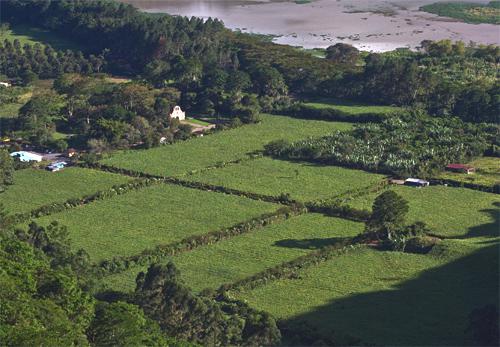
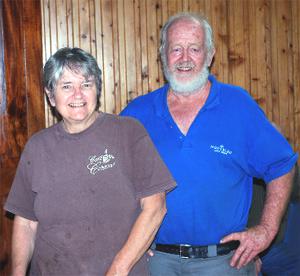 Going early gives the opportunity to reunite with guide and colleague Ernesto Carman Jr., his wife Ela, and 'Nesto's parents--Linda and Ernie Carman
Going early gives the opportunity to reunite with guide and colleague Ernesto Carman Jr., his wife Ela, and 'Nesto's parents--Linda and Ernie Carman  Since 2011 Andrea has provided valuable assistance to our project by maintaining a half-dozen hummingbird feeders around the restaurant; her cooperation had significant positive impact on our 2012 expedition--as we'll describe below.
Since 2011 Andrea has provided valuable assistance to our project by maintaining a half-dozen hummingbird feeders around the restaurant; her cooperation had significant positive impact on our 2012 expedition--as we'll describe below.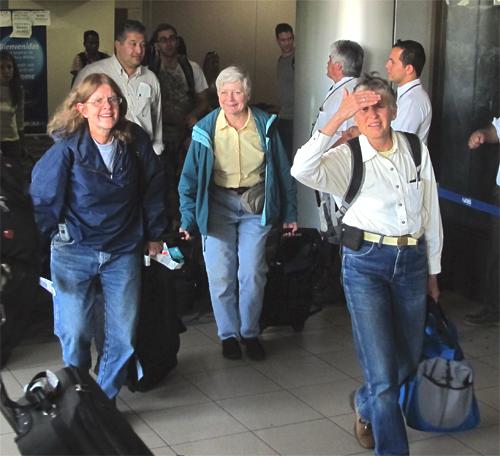

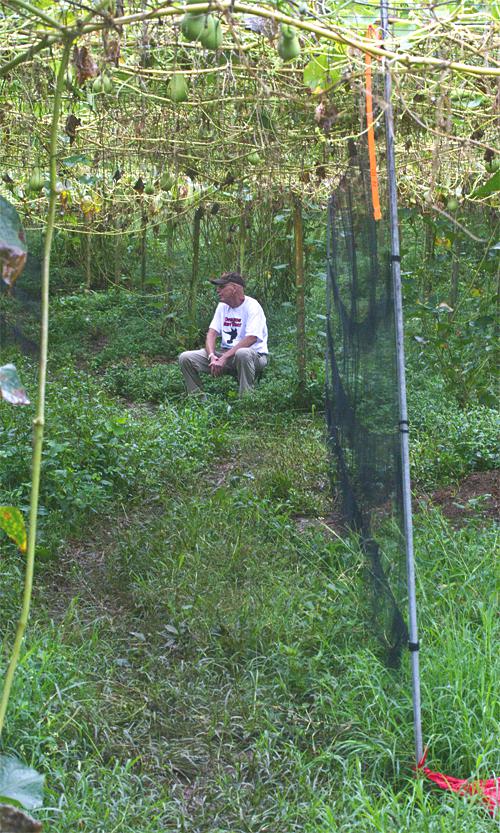
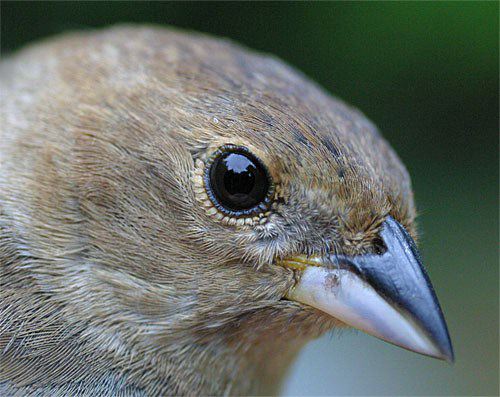

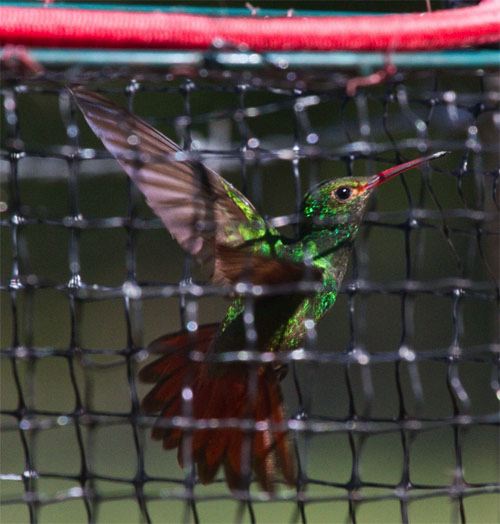
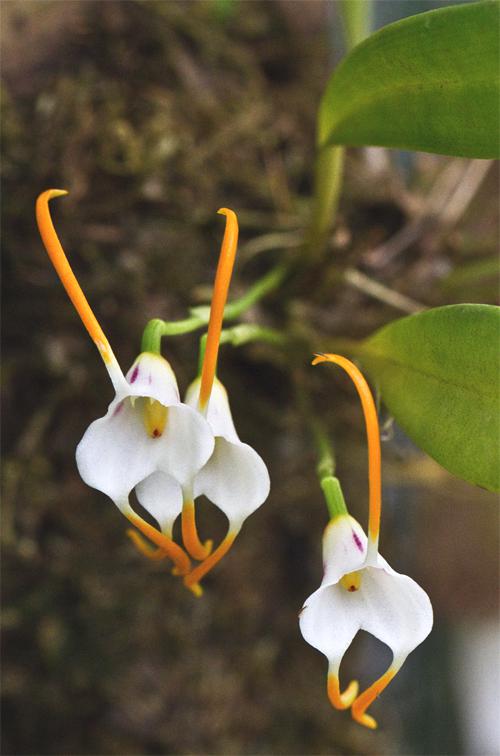
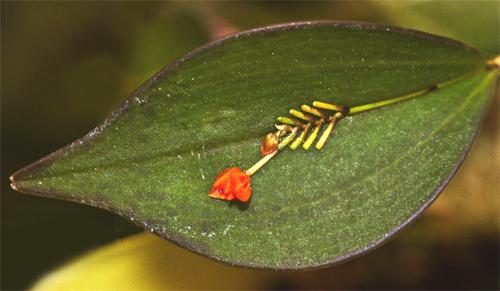
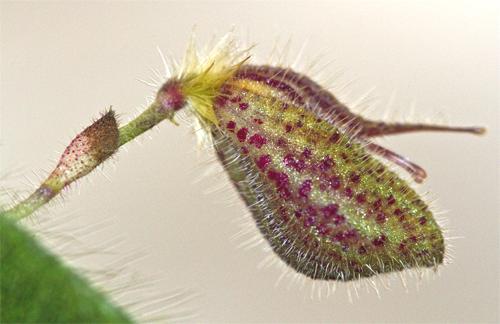
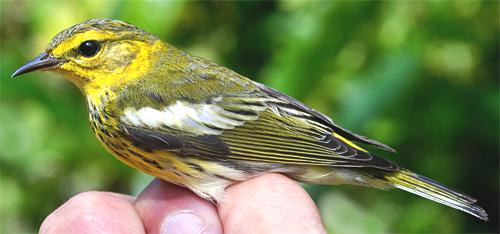
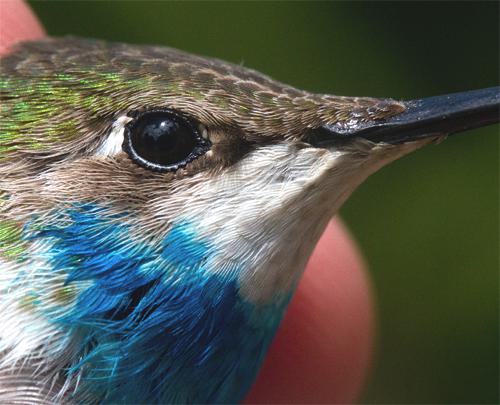
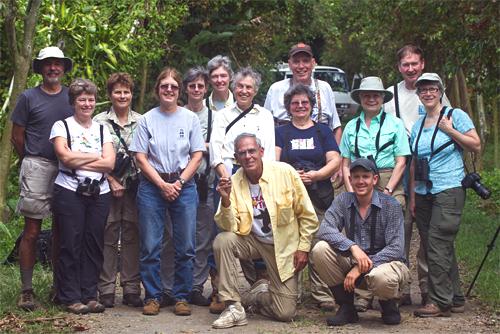
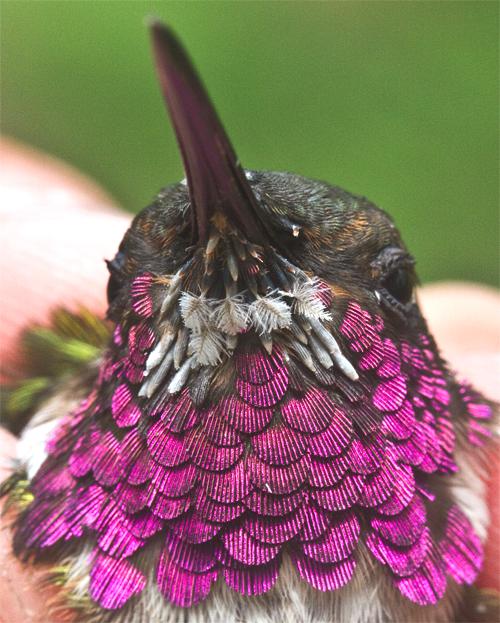
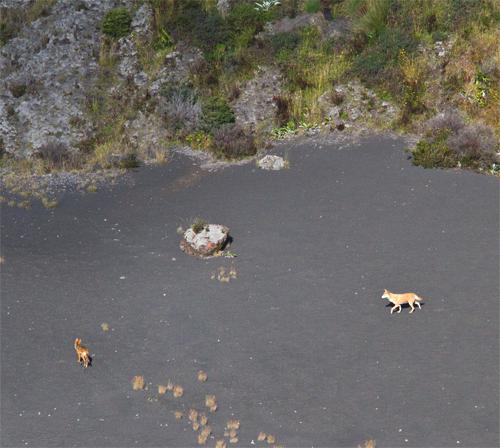
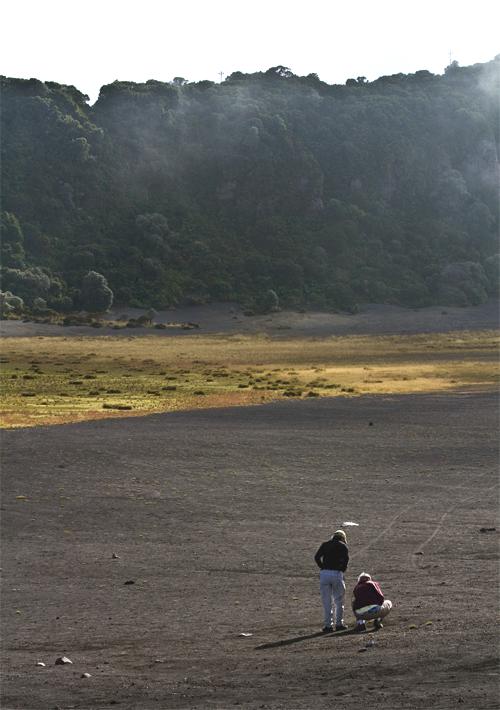
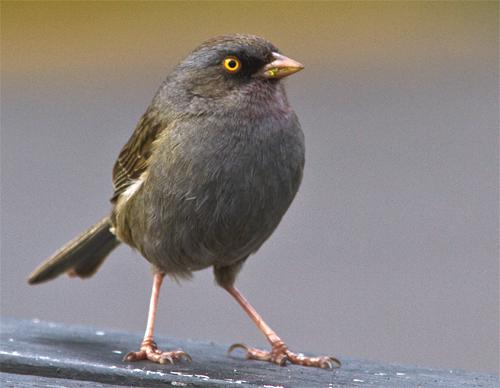
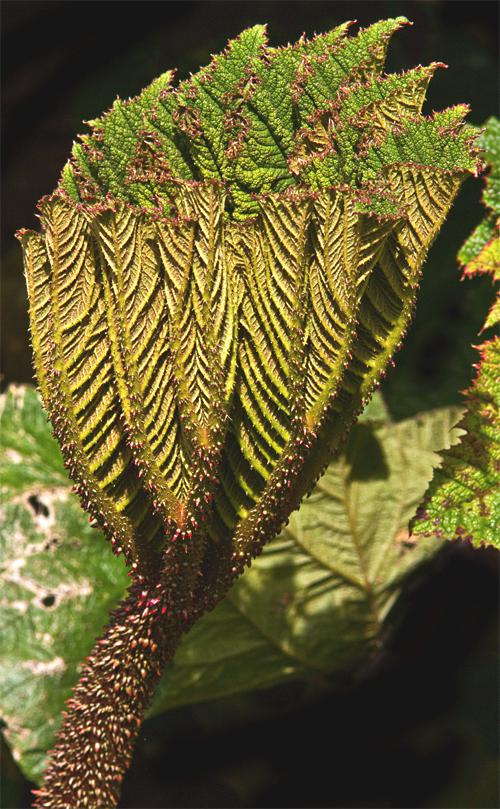
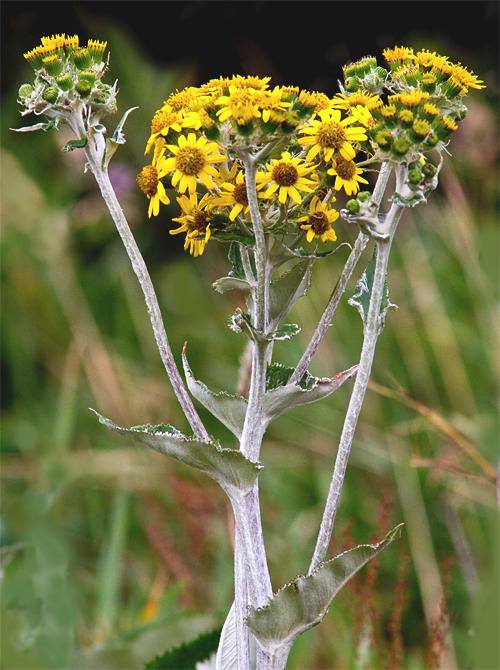
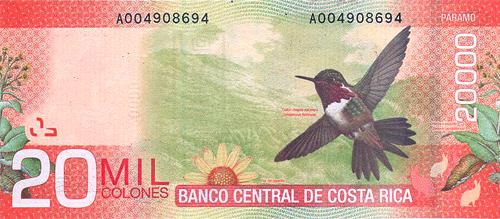
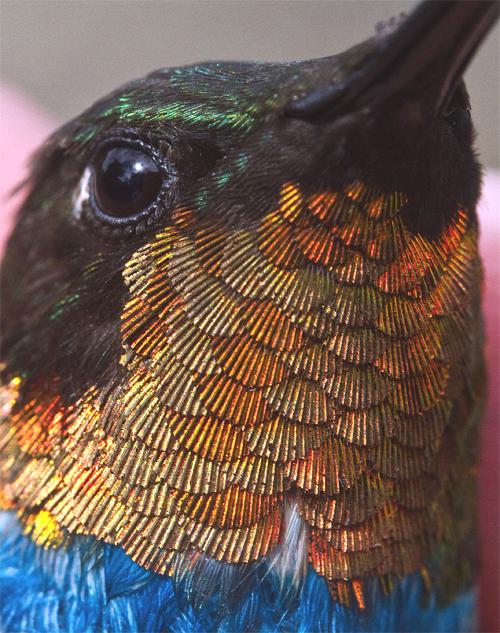
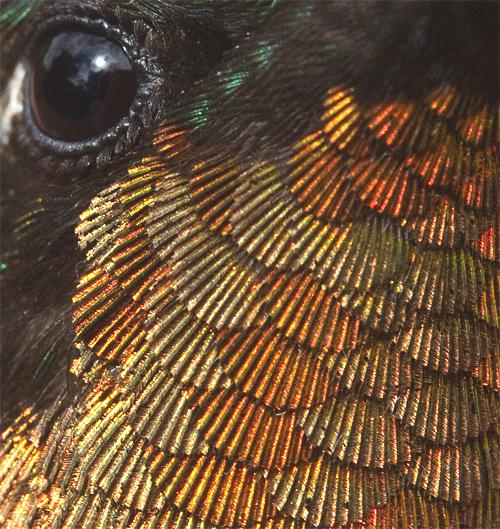

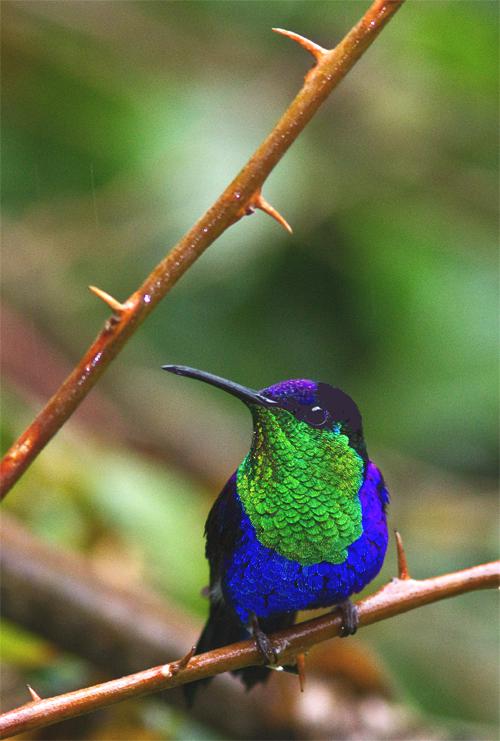
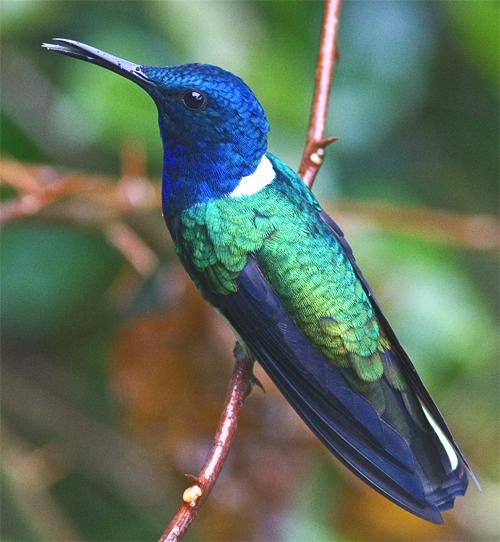
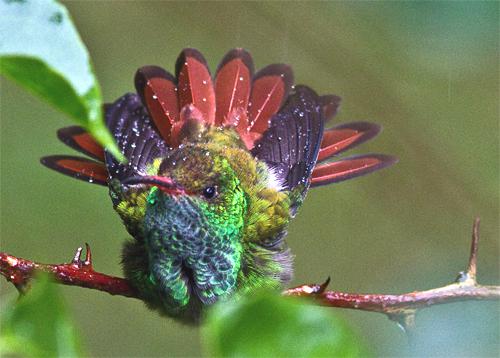
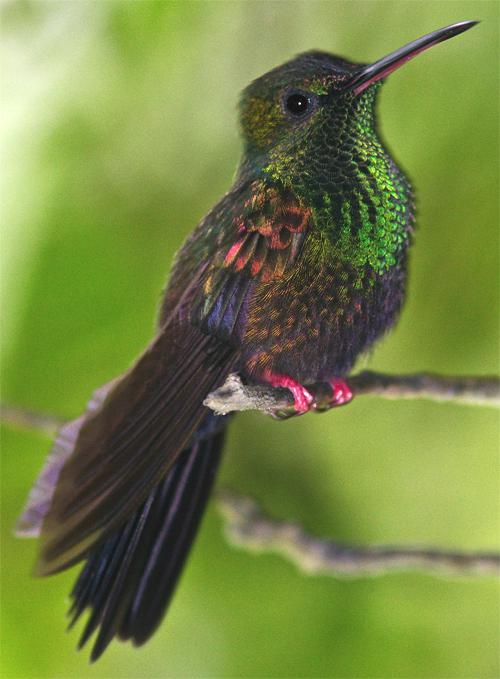
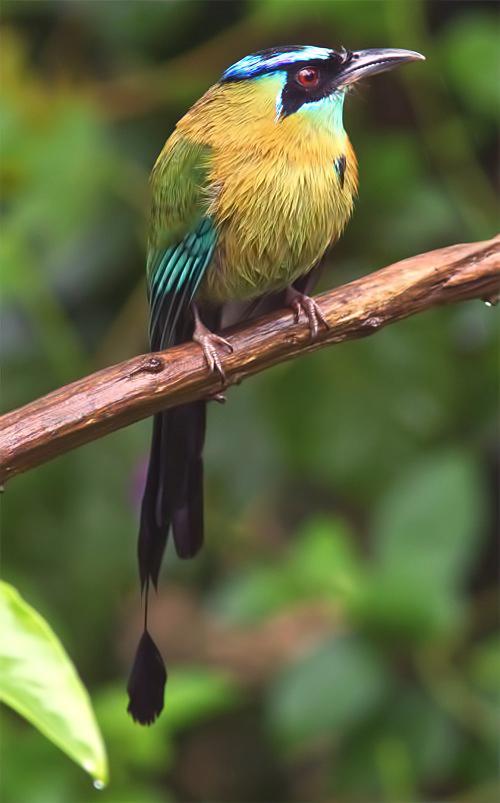
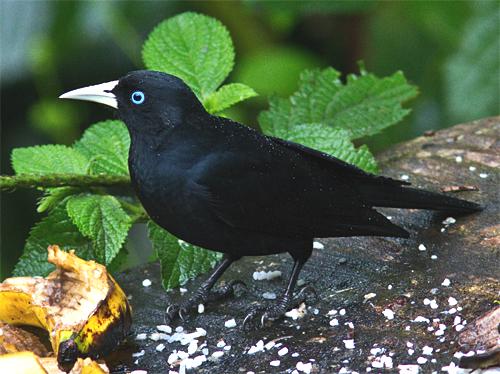
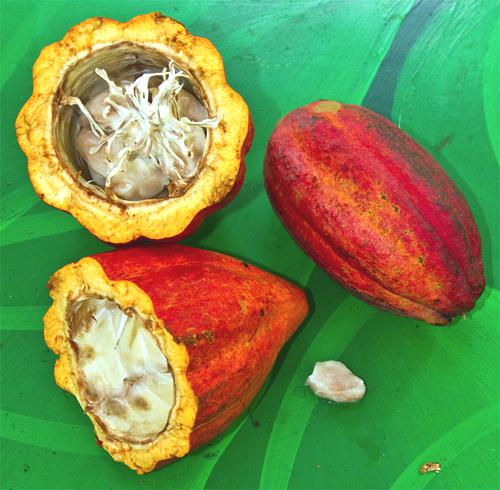
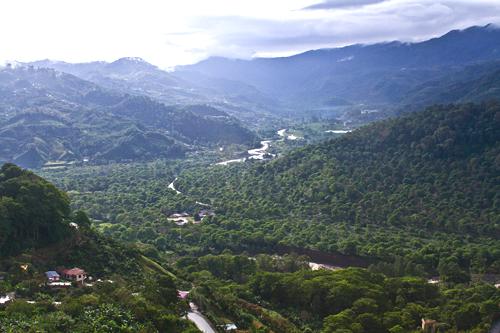
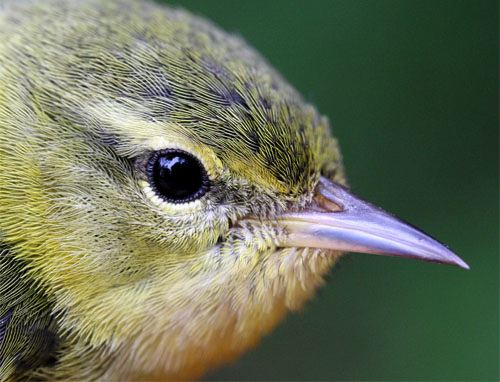

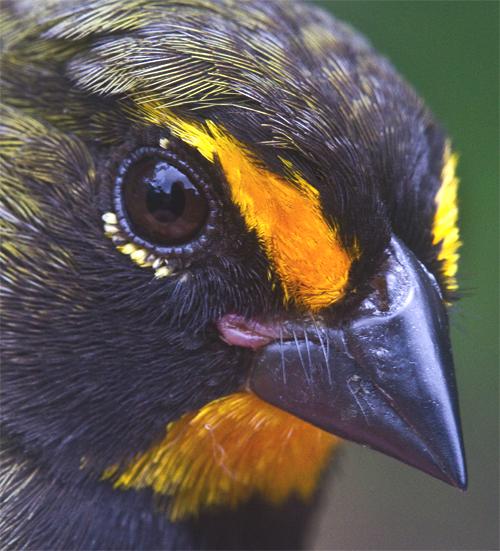
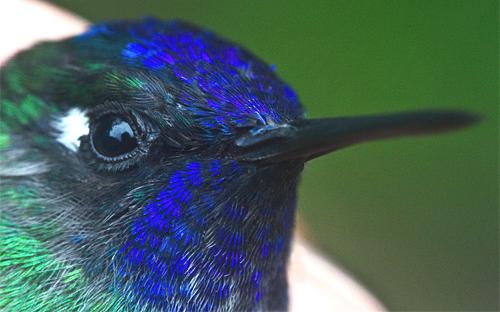

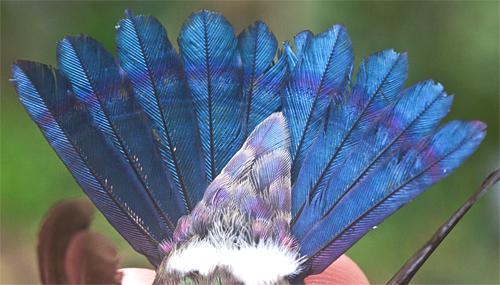
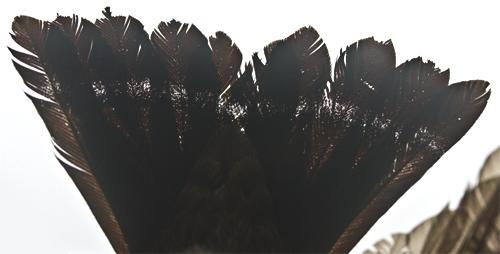
 and after a new hummer-species-in-the-hand in Plot #4, anything else might have seemed anticlimactic, but as soon as the team shut down mist nets we hopped on the bus for the reason we suspect our six veterans REALLY came on this Operation RubyThroat expedition to Costa Rica East: To visit the famous Finca Cristina--Ernesto's childhood home they had been hearing about for years.
and after a new hummer-species-in-the-hand in Plot #4, anything else might have seemed anticlimactic, but as soon as the team shut down mist nets we hopped on the bus for the reason we suspect our six veterans REALLY came on this Operation RubyThroat expedition to Costa Rica East: To visit the famous Finca Cristina--Ernesto's childhood home they had been hearing about for years.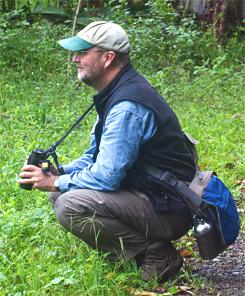 Mark leads tours to Costa Rica and elsewhere for New Jersey Audubon and has always promised to come visit one of our study sites to see first-hand what we're doing to learn more about Ruby-throated Hummingbirds on Neotropical wintering grounds. Mark knew Ernesto from previous trips to Costa Rica and ended up staying at the finca by night, helping out in the Chayote fields during the day. Accompanying Mark was Marco Antonio Morales Aguilar--better known as
Mark leads tours to Costa Rica and elsewhere for New Jersey Audubon and has always promised to come visit one of our study sites to see first-hand what we're doing to learn more about Ruby-throated Hummingbirds on Neotropical wintering grounds. Mark knew Ernesto from previous trips to Costa Rica and ended up staying at the finca by night, helping out in the Chayote fields during the day. Accompanying Mark was Marco Antonio Morales Aguilar--better known as 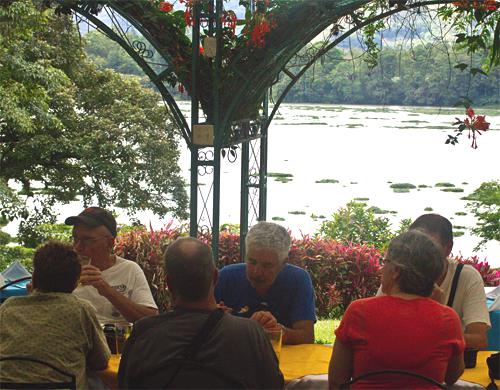
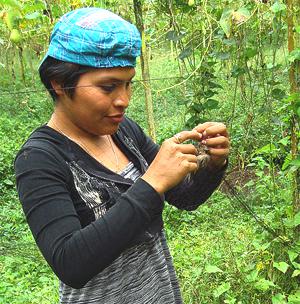 In addition to providing an excellent luncheon buffet, the site offered fond memories as the place where trip leader Hilton was honored to serve as "best man" when Ernesto and Ela
In addition to providing an excellent luncheon buffet, the site offered fond memories as the place where trip leader Hilton was honored to serve as "best man" when Ernesto and Ela 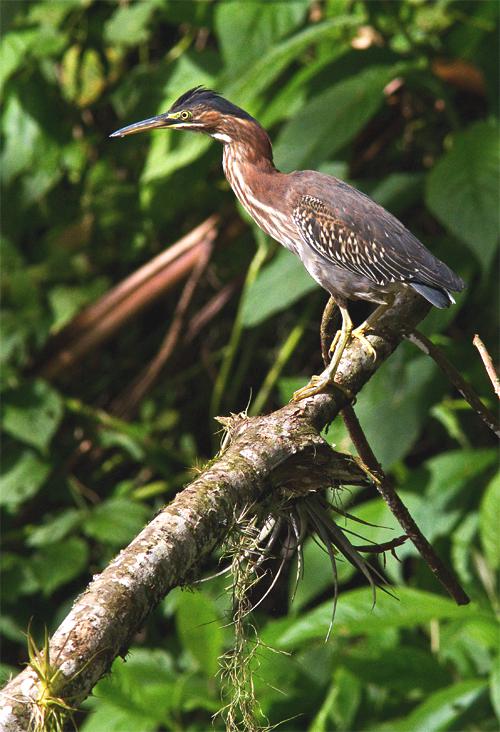


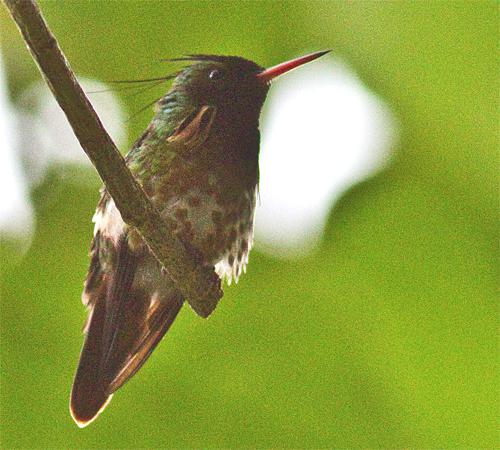

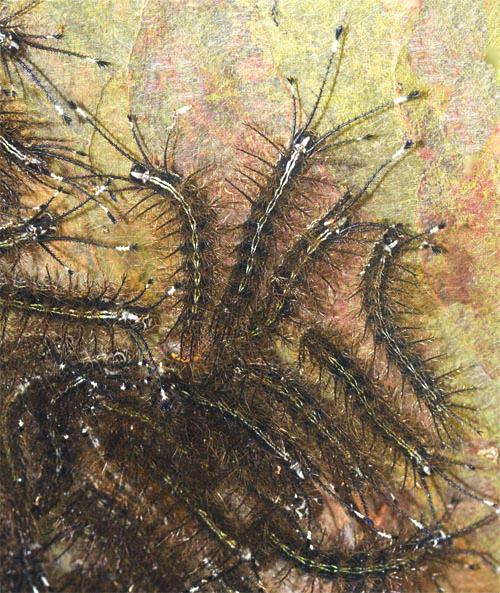
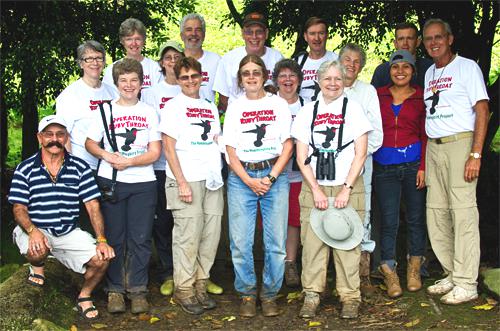
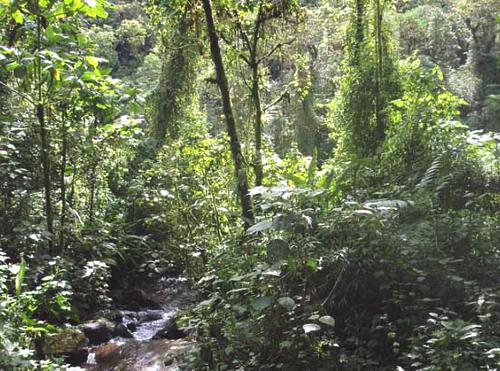
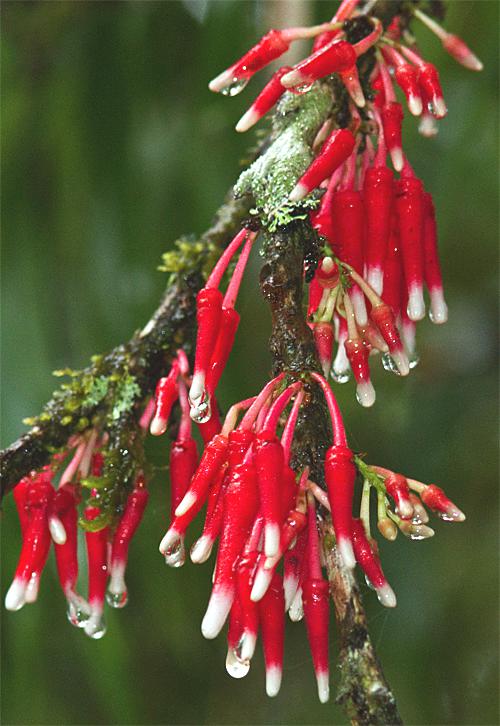

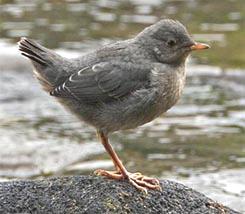 At the first rivulet--nothing. Around the second creek--the same. Third watercourse--no dice, and no ouzel. With light almost gone we stopped at the last little river along the route and strained our eyes upstream and downstream. Look-alike Black Phoebes taunted us by flitting from one boulder to the next until someone on the bus screamed out "Ouzel!" And, sure enough, hopping from rock to rock and occasionally diving into rippling water was the object of our quest: A pale gray, bob-tailed
At the first rivulet--nothing. Around the second creek--the same. Third watercourse--no dice, and no ouzel. With light almost gone we stopped at the last little river along the route and strained our eyes upstream and downstream. Look-alike Black Phoebes taunted us by flitting from one boulder to the next until someone on the bus screamed out "Ouzel!" And, sure enough, hopping from rock to rock and occasionally diving into rippling water was the object of our quest: A pale gray, bob-tailed 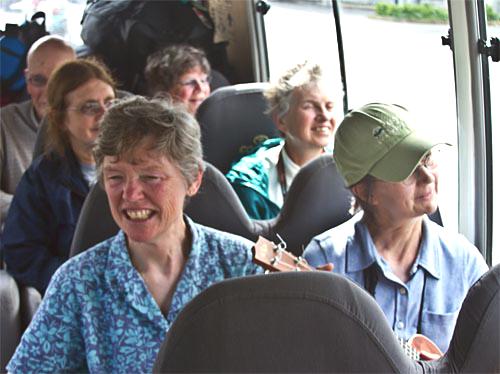
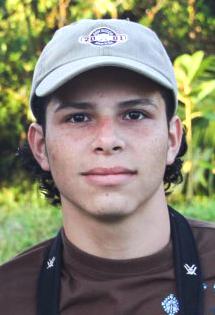 There we had a tasty lunch with Linda and Ernie before going down to El Cas, hoping to add to the 45 RTHU we'd banded with the Chayodoce.
There we had a tasty lunch with Linda and Ernie before going down to El Cas, hoping to add to the 45 RTHU we'd banded with the Chayodoce.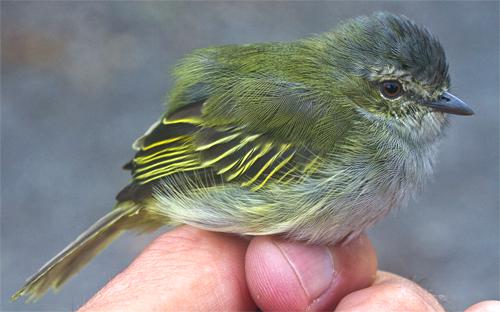
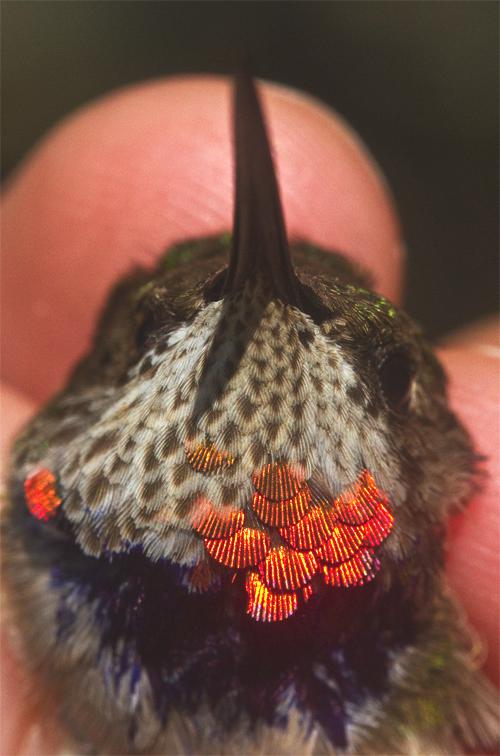
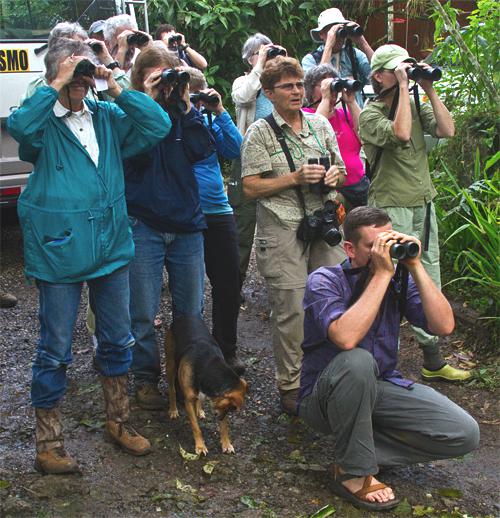


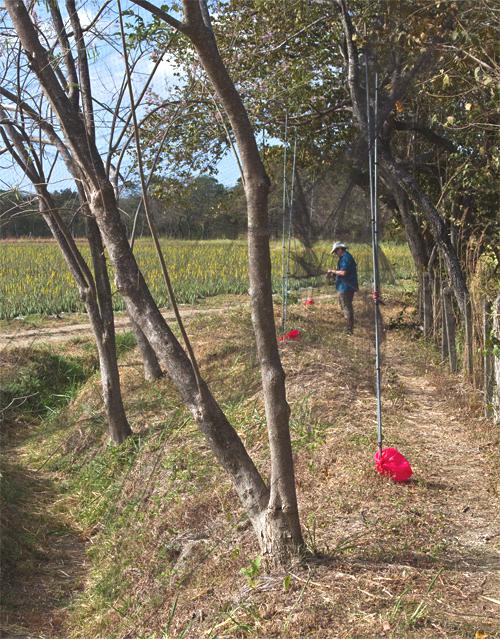 Numerous alumni
Numerous alumni 
 Oct 15 to Mar 15:
Oct 15 to Mar 15: